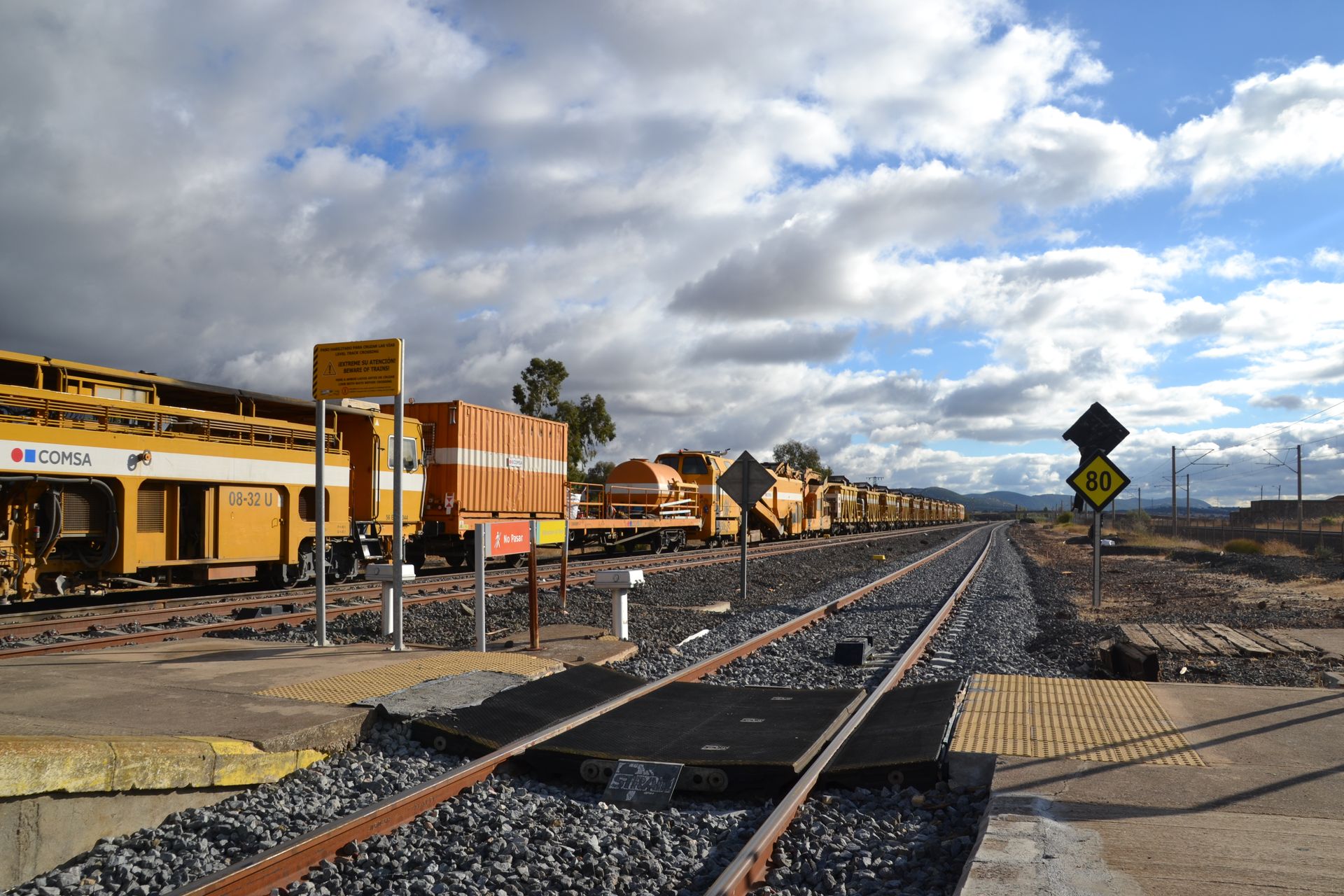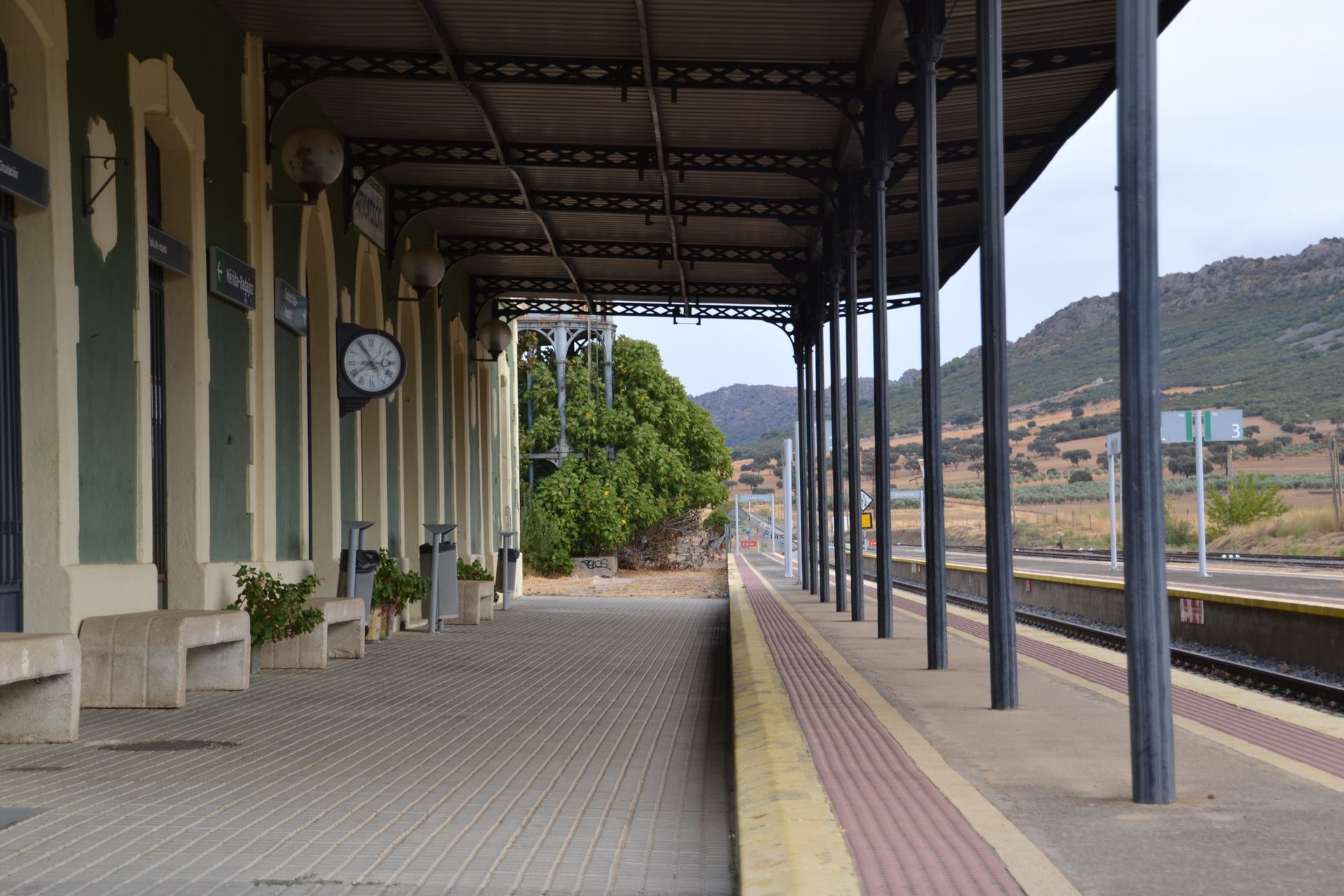Puertollano-Mercancías – Mérida
CHARACTERISTICS
- Estación de Puertollano-Mercancías (UTM 30S 400510 4281598); (P.K. 217,000) / VM
- Estación de Brazatortas-Veredas (UTM 30S 385462 4280846); (P.K. 232,600) / VM
- Estación de Almadenejos-Almadén (UTM 30S 349613 4289402); (P.K. 272,900) / VM
- Estación de Guadalmez-Los Pedroches (UTM 30S 332193 4285165); (P.K. 294,300) / VM
- Estación de Cabeza del Buey (UTM 30S 306438 4288503); (P.K. 325,300) / VM
- Estación de Almorchón (UTM 30S 300808 4285599); (P.K. 331,700) / VM
- Estación de Castuera (UTM 30S 279061 4290438); (P.K. 356,000) / VM
- Estación de Campanario (UTM 30S 270785 4303824); (P.K. 374,800) / VM
- Estación de Villanueva de la Serena (UTM 30S 257727 4317035); (P.K. 394,100)/ VM
- Estación de Don Benito (UTM 30S 251961 4316991); (P.K. 400,200) / VM
- Estación de Valdetorres (UTM 29S 754062 4311216); (P.K. 419,400) / VM
- Estación de Guareña (UTM 29S 748971 4309232); (P.K. 424,900) / VM
- Estación de Mérida (UTM 29S 730310 4311388); (P.K. 453,000) / VM
The Puertollano-Mercancías – Mérida railway section belongs to the 520 Ciudad Real-Badajoz line, whose history began in March 1861 with the creation of the Compañía de los Caminos de Hierro de Ciudad Real a Badajoz, CRB, whose objective was to carry out the project and construction of the railway line between these two cities. Its construction had been authorised two years earlier, with the idea of a rail link from Portugal to Badajoz and Ciudad Real, where it would connect with Madrid via the railway line belonging to the Madrid to Zaragoza and Alicante Railway Company, MZA. [1] [2] [3]
Its construction had been authorised two years earlier, with the idea of a railway link from Portugal to Badajoz and Ciudad Real [...]
Construction work on the line began in the same year that the CRB was created and the different sections were successively put into service: in September 1863 the section between the Portuguese border and Badajoz; in August 1864, the section between Ciudad Real and Puertollano; in October of the same year the link between Badajoz and Mérida; in 1865, the sections between Puertollano and Veredas and between Mérida and Magacela. In 1866, the works were completed with the opening of the Magacela-Castuera, Castuera-Almorchón and Almorchón-Veredas sections. The line was fully commissioned on 22 November 1866. [2] [3]
The line was fully commissioned on 22 November 1866.
A few years later, in 1871, the CRB, after undertaking the construction of a branch line from Almorchón to Belmez, declared itself insolvent. However, it negotiated the debt with its creditors on the basis of a new project, the construction of a direct railway line between Madrid and Ciudad Real, which would make its traffic to the capital independent of MZA. CRB obtained the concession in 1876 and in February 1879 the new Madrid-Ciudad Real line was opened, connecting with the Ciudad Real-Badajoz line via the Empalme de Torrubia junction. Despite the speed with which the new line was built, in 1880 MZA absorbed CRB and became the owner of all its lines. [2] [3] [4] [5]

Vista de andén en la estación de Puertollano (Ciudad Real)
Under the administration of MZA, Mérida consolidated its position as an important railway junction. The construction of the Aljucén-Cáceres branch line in 1884 increased the railway network, diversifying routes and linking the south of Extremadura with Seville, connecting with the Madrid-Valencia de Alcántara and Mérida-Los Rosales lines.
In 1941, when the Iberian gauge railway network as a whole was nationalised, it became part of RENFE, which subsequently, with the aim of improving transport to the Puertollano refinery, built a 9.6 km branch line linking it to Puertollano station, which was put into service in March 1975, and electrified the section from this station to Ciudad Real. [6]
Under the administration of MZA, Mérida consolidated its position as an important railway junction.
With the construction of the Madrid-Seville high-speed line, inaugurated in 1992, a new station was built in Ciudad Real, which required the construction of an access variant for the Ciudad Real-Badajoz line. The link to the old station was eliminated.
In 2005, with the extinction of RENFE, under the framework of Law 39/2003 of the Railway Sector, the line came under the control of Adif like the rest of the RFIG of the State.
Currently, freight, medium-distance and regional express trains run on this line. On the other hand, there is a proposal to include the railway line between Mérida and Manzanares in the Basic Rail Freight Network in the context of the Meseta-Portugal connection as part of the Atlantic Corridor project, one of the nine corridors that make up the Trans-European Transport Network (TEN-T). [6] This makes it possible in the future to carry out important projects to improve the line that will optimise the rail services that can be offered. For example, in April 2024 the Environmental Impact Statement (EIS) was approved for its 225 kV electrification and in December 2024 Adif tendered the infrastructure improvement of four stations: Belalcázar, Almorchón, Castuera and Campanario, including the complete renovation of sleepers, ballast, rails and track apparatus, as well as the extension of the useful length of sidings to 750 metres.
Currently, there are medium-distance and regional express freight trains in operation.
The line crosses the region of La Serena, with areas of pasture on the easternmost side (Castuera, Quintana de la Serena) and a predominance of cultivated fields as it approaches Villanueva de la Serena and Don Benito. The entrance to Mérida is along the river Guadiana, so the landscape changes along the route.
The line crosses the region of La Serena, with areas of pastureland on the easternmost side and a predominance of cultivated fields as it approaches Villanueva de la Serena and Don Benito.
The perception of the line’s tourist potential is low. The station buildings, especially those outside population centres, have had various fates: abandoned and partially demolished (Medellín), closed and boarded-up hostel (Quintana de la Sierra), renovated municipal centre removed from the station grounds (Campanario) and building maintained by Adif (Guareña). It is worth noting that Medellín is home to a castle and a Roman theatre, making it a historically significant site, but the station (building and platforms) has been dismantled and demolished.
Category B2.
Non-electrified track with concrete sleepers in need of repair.
Photographic report

Estación de Brazatortas (Ciudad Real)

Apartadero de Guadalmez - Los Pedroches (Ciudad Real)

Apartadero de Almorchón (Badajoz)

Estación de Belalcázar (Córdoba)
References
-
J. R. Lázaro, Los primeros ferrocarriles. Ediciones Akal, 2000.
-
F. Wais, Historia de los ferrocarriles españoles. Editora Nacional, 1974.
-
J. P. Torner, «Ciudad Real a Badajoz (y Almorchón a las minas de Carbón de Bélmez)», Ferrocarriles de España, 22-feb-2012. [En línea]. Ver referencia
-
F. Comín, 150 años de historia de los ferrocarriles españoles. Grupo Anaya, 1998.
-
. P. E. García, «El ferrocarril de Madrid a Ciudad Real (1878-1988)», Docutren.com. [En línea]. Ver referencia
-
J. G. Raya, «Cronología básica del ferrocarril español de vía ancha», IV Congreso Historia Ferroviaria: Málaga, sep-2006. [En línea]. Ver referencia
-
Minsterio de Transportes y Movilidad Sostenible. 2024 Ver referencia
-
Adif. 2024 Ver referencia